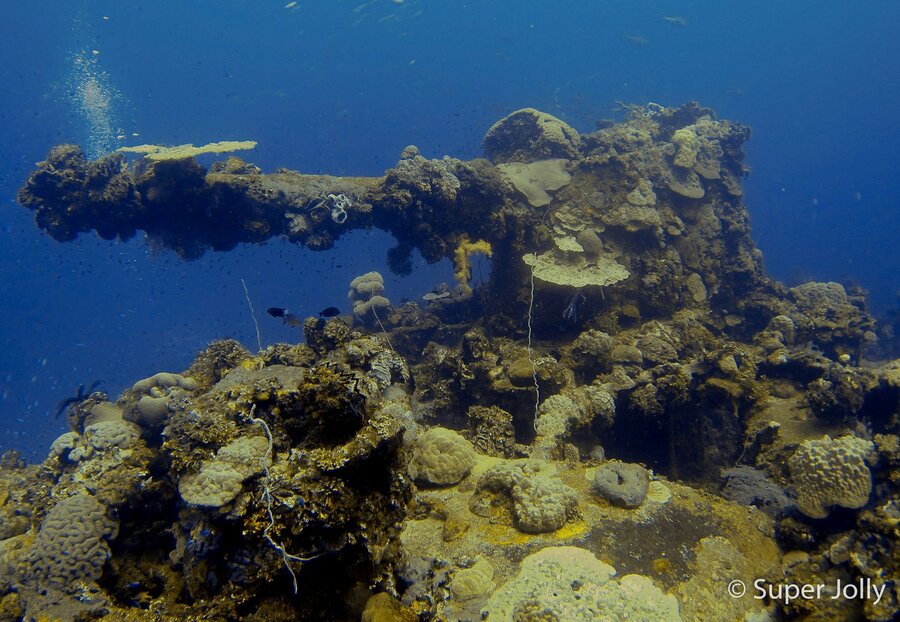

reported once before possibly mutant sharks missing their second dorsal fin.

It was then they realized that on that day, America was testing its hydrogen bomb in Bikini Atoll. 'The terrible history of Bikini Atoll is an ironic. Some of them thought it was the sun, but Kuboyama, the boat’s chief radioman realized that it was a bomb. On March 1 st, in the same year, they were going to catch some more fish when they saw a huge flash light and big mushroom cloud. They did catch lots of fish there, without knowing what would come out the next day.

One day, the fish net got broken so they decided to go south from where they were, towards Bikini Atoll, near Marshall Island, so they can catch fish using smaller nets and spears. So they headed east and started to catch big fish. The chief said that they would catch bigger fish in the east. It was when one of the crew realized that the boat was heading east rather than south, where they usually go to, because they were not informed by the chief. They sang, played guitar, and do other fun things. With twenty three crews aboard, they started the journey happily. Stephen Palumbi is director of Stanford’s Hopkins Marine Station and a senior fellow at the Stanford Woods Institute for the Environment.On January 22 nd, 1954, a Japanese fishing boat called the ‘Daigo Fukuryu Maru’ started its sailing to go fishing for two months. The former island paradise of Bikini Atoll is slowing blooming back to life, 70 years after the United States dropped 23 nuclear bombs on it, including a device in 1954 that was 1,100-times larger. “We should learn everything we can from it, even things we would have never have thought of before.” “We should never forget what we did to Bikini Atoll and its people,” López said. How do the crabs survive, grow and reproduce with such a burden of radioactivity? To answer this and other questions about radiation’s genetic impacts, López and Palumbi will also compare their species samples with specimens collected on Bikini by Smithsonian Institution researchers just before the atomic tests. Aur Atoll Bikar Atoll Bikini Atoll Ebon Atoll Enewetak Atoll Erikub Atoll Jabat Island Jaluit Atoll Jemo Island Kili Island Kwajalein Atoll Atolls L-W. To that end, López, the project’s leader, decided to also look at platter-size crabs that eat coconuts filled with a radioactive isotope from groundwater. A film crew captured Palumbi and López diving in a hydrogen bomb crater, chasing radioactive crabs, sampling giant corals and witnessing something only reported once before – possibly mutant sharks missing their second dorsal fin.īeyond coral, López and Palumbi aim to understand how Bikini’s larger ecosystem continues to thrive in terms of biodiversity and to expose any hidden genetic damage. The blasts, detonated in the years between 19, exposed corals and other species to persistent, high levels of radioactivity. To start viewing messages, select the forum that you want to visit from the selection below. You may have to register before you can post: click the register link above to proceed. The episode explores, among other stories, the historic fallout of 23 atomic bomb tests in the most northern of the Marshall Islands, located roughly halfway between Hawaii and Japan. New Topics Todays Posts Member List Calendar Forum Talk About It Worldwide Cannabis Guide If this is your first visit, be sure to check out the FAQ by clicking the link above.
#Bikini atoll mutated sharks series
The researchers’ work is featured in the June 28 episode of “ Big Pacific,” a five-week PBS series about species, natural phenomena and behaviors of the Pacific Ocean. Palumbi and biology graduate student Elora López hope to better understand how the coral colonies withstand the high levels of radiation by sequencing their DNA and measuring rates and patterns of mutations. Yet somehow, fast-growing coral in Bikini Atoll appear unharmed by the high levels of radiation found there. Humans and many other animals exposed to radiation often develop DNA mutations in fast-dividing tissues that can result in cancer. “By understanding how corals could have recolonized the radiation-filled bomb craters, maybe we can discover something new about keeping DNA intact.” “The terrible history of Bikini Atoll is an ironic setting for research that might help people live longer,” said Stephen Palumbi, the Harold A.

tested atomic bombs on a ring of sand in the Pacific Ocean called Bikini Atoll, Stanford researchers are studying how long-term radiation exposure there has affected corals that normally grow for centuries without developing cancer.


 0 kommentar(er)
0 kommentar(er)
